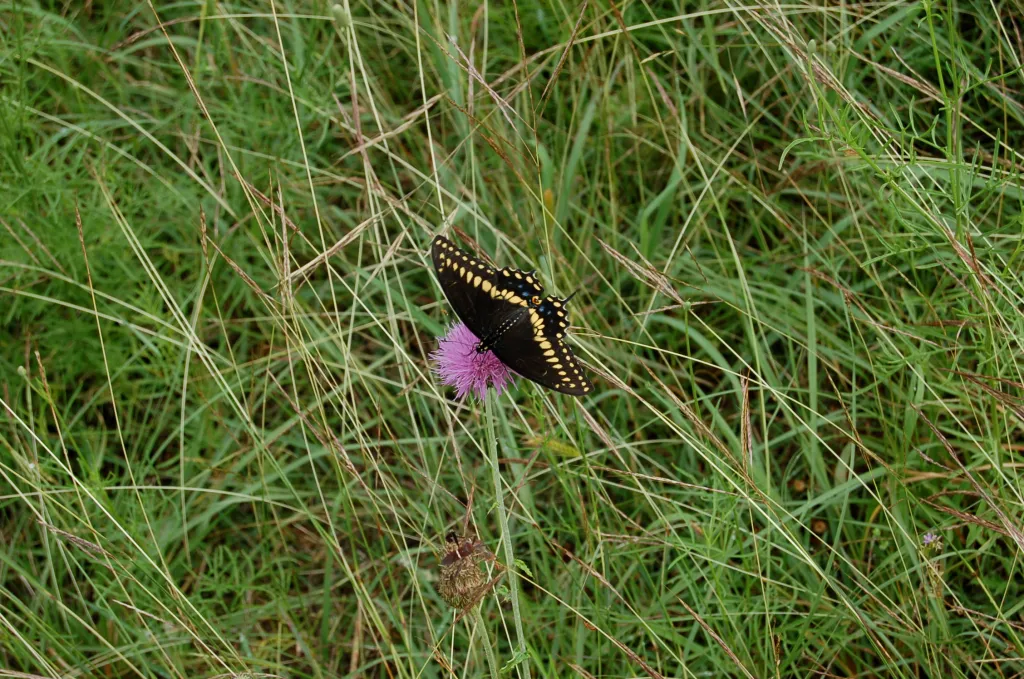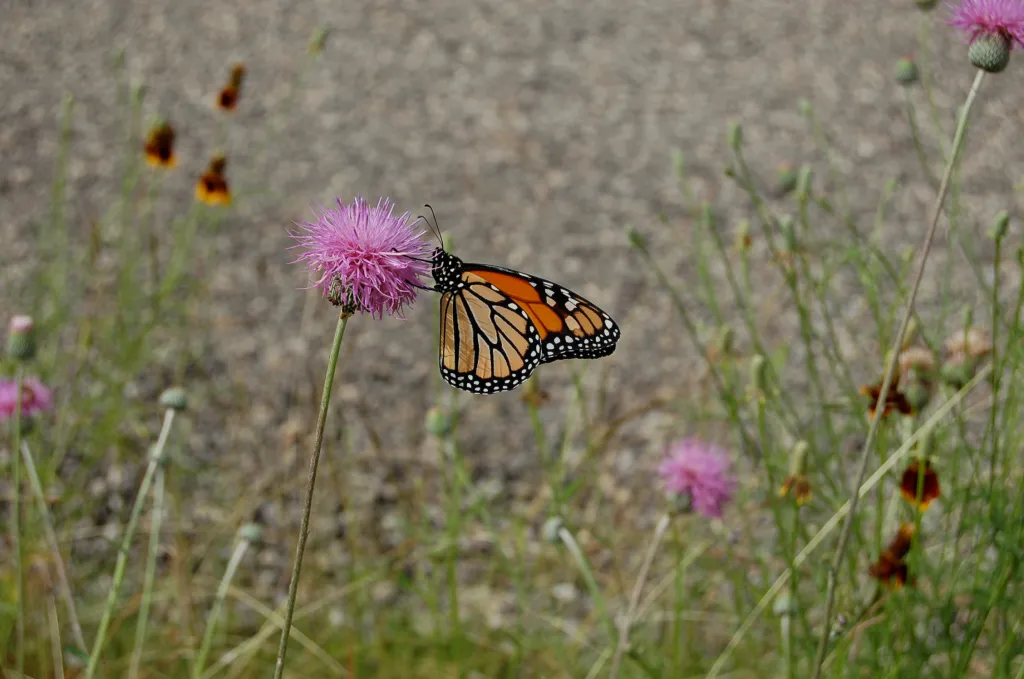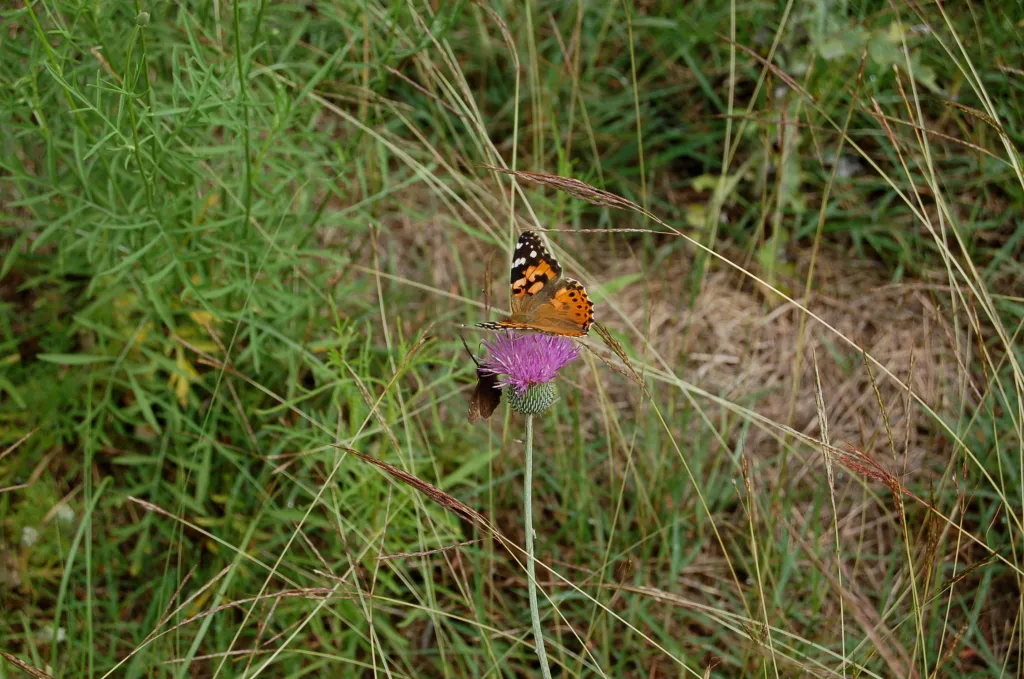By Delmar Cain
It would be right of you to ask why I, the current president of the Boerne Chapter of the Native Plant Society of Texas, have an oleander (Nerium oleander) in my yard. It is not prominent but then again neither is it hidden beside the path at the side of the house. Yes, I said an oleander, a native of Morocco, Portugal, the Sahara and even the southern parts of China. But it is not native to Texas. But the question is not why I have an oleander now, which I can answer. A better question is why did Woody, or any one else in Texas, have one in the first place.

But this is a tale of two plants. I also have the other plant in my yard. In fact, I had several last year, which I allowed to go to seed so that I will have more plants this year. When I tell you what the plant is I can just hear the chorus: “You’ll be sorry.” The second plant is a biennial to weak perennial, the Texas thistle (Cirsium texanum) and it is a native to the Hill Country.
The Texas thistle is not called a thistle inadvertently. It is an herb that has stickers –3 to 9– on each side of each leaf. It can be either single stemmed or multi-branched and grows 2-6 feet tall. This plant thrives in dry soils and prairies, along the roadsides and even in places where it is not invited. In fact, in more that one natural area, I have heard a caretaker say, “Take it out”.
But with its prickles, the Texas thistle also has a sweet side. In April to July, when it blooms with a dark pink disk flower on each stem, it is a magnet for many types of butterflies and pollinators. On a good day a host of butterflies and some insects, that I am unable to identify, flit among its blooms. Larva of the Painted Lady butterfly feed on the foliage and bumblebees visit the mature flowers. Finally, if the flowers are allowed to progress to seed, finches will feed on the seeds and use the silky fluff to line their nests. As Bill Ward would say, “Now that is my kind of plant.”

Oh, and did I say you won’t have to worry about it returning next year. If given the least bit of inattention, it will be back for another season. And although there are other thistles that are listed as invasive plants, including two in our area from Europe that are really bad actors, (Malta Star-Thistle [Centaurea melitensis] and Musk-Thistle [Carduus nutans]), the Texas thistle is reasonably well behaved.
But the oleander is no wimp. It is an evergreen shrub or small tree which typically occurs in its native habitat in dry streambeds but has been planted in this country as an ornamental, especially in landscapes, parks and along roadsides. It has been used because it tolerates drought, grows in poor soils and is deer resistant. The one I have blooms with red flowers. So you might ask, “what’s the problem?”
Here is the downside. Commonly used around playgrounds and in residential landscapes, the oleander is one of the most poisonous commonly grown plants in the world with toxins that can be fatal if ingested in sufficient amounts. Its leaves are hazardous to sheep, horses and cattle and even the smoke from burning its branches can be harmful. Yet, unlike the Texas thistle which can’t be bought, the oleander can be purchased at most nurseries and at large home improvement stores and can often be seen growing near school grounds and around public buildings.

Although toxicity is a problem, I have more basic issue with the oleander. I have yet to see a single bird, bee or butterfly on my oleander. It takes up space in my yard, it has a few colorful blooms, but it gives nothing back to any of the other occupants or visitors to my landscape. Yes, it is a host plant to the Common Crow Butterfly, a butterfly that just happens to live only in Asia, where the oleander is a native. If all of the plants in my Texas yard were as sterile as the oleander, I could not expect birds, bees or butterflies to visit; and I would be much the poorer for it.
Woody and Thelma Isenhardt, friends who live in College Station, gave the oleander to me when I retired to remind me of Woody’s struggle to rid their yard of an oleander, which he found blocking a window at their home. On multiple occasions Woody had cut, dug, burned, and attempted to poison the bush, only to see it return with terminator-like vigor. He finally decided to dig around it, tie a rope on it and pull it out with his truck. Unfortunately, the rope tightened, then snapped and the whiplash broke all of the windows across the front of the house. But his neighbor dealt the cruelest cut when he came by and asked, “What did you have Woody—a drive-by shooting?”
Now you know why I planted an oleander–friendship. But how did oleanders get to this country? According to the International Oleander Society we can thank (or condemn) Joseph Osterman, a Galveston merchant, who returned with the first plants in 1841; whereupon, the Galveston members of the Women’s Health Protective Association (apparently choosing to equate health with beauty and ignore toxicity) gladly planted them throughout the city. I wonder if I could interest that group in the Texas thistle.
